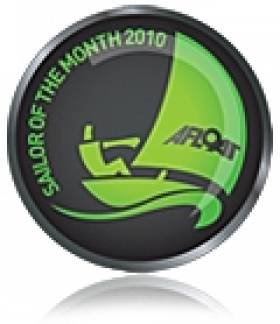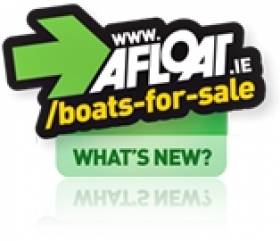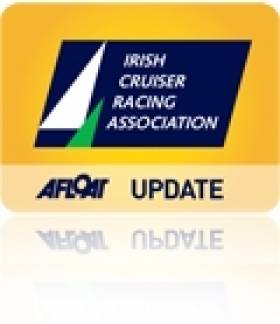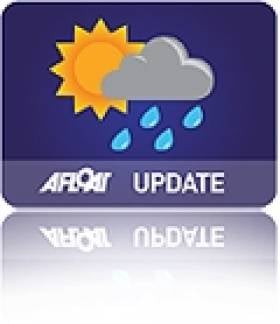Displaying items by tag: Afloat
John Sheehy is October's Sailor of the Month
John Sheehy of Dun Laoghaire is the latest Afloat.ie/Irish Independent "Sailor of the Month" after his convincing recovery to retain his title as National Match Racing Champion in Kinsale on October 24th.
Recovery and retention became the theme of a hotly-fought series, as Sheehy had seemed to be off form on the opening day, far from overnight leader, in the doldrums way back in fourth. Things were still rocky on the second day as they battled on all fronts to stay in contention after taking a beating from Ben Duncan of Howth, who seemed on track to be the new champion.
But Sheehy and his crew sailed off on their own for a brief onboard motivation session. He had a crew of all the talents in Darragh O'Connor, Paddy Kirwan and Marty O'Leary and they returned to the fray fired up on all cylinders to go into the final series with eight wins, while Duncan had nine.
However, by this stage there was no stopping the John Sheehy onslaught. He clinched two more excellent starts and retained the lead despite ferocious pressure in both matches from Ben Duncan, who was clear second overall, while Sam Hunt was third, narrowly ahead of Prof O'Connell.
Afloat.ie - Site Upgrade Underway
Afloat Magazine. Ireland's Sailing, Boating and Maritime Publication
Afloat now in its 43rd year of production is a vibrant specialist magazine which has continually adapted to the demands of its readership, with an industry insight which is quite simply unique. Edited by David O'Brien (47), a former European and World sailing champion and Olympic sailor from the 2000 Games, it is produced by a group of dedicated watersports enthusiasts and has become essential reading for all those who have more than a passing interest in the development of Irish watersports.
Afloat is the only publication dedicated to serving the needs of the sector, and it does so with a truly independent voice. Afloat's association with the industry's twin governing bodies the ISA and IMF allows it to offer an insider view, but the magazine maintains independent editorial control.
Packaged as a glossy magazine with an emphasis on colour photography, no other specialist magazine in Ireland offers such an impressive range of comment, information and advice in such an attractive format.
Click the links below for more on Ireland's sailing and boating magazine:
'Raging Bull' Overtakes 'Errislannan' in 'Boat of the Year' Poll
Raging Bull overtook Errislannan in Afloat readers opinion poll at lunch time on who will win the Irish Cruiser Racing Association (ICRA) Boat of the Year Award, in just over a month's time. Over 350 voters have given their opinion so far on the ten boat shortlist produced by Afloat. Errislannan proved an early poll topper since voting began last Thursday but as late as lunchtime today votes for Raging Bull saw a dramatic lift, bringing the Irish Sea offshore champion ahead of the Top Cork week Sigma 38. At 2pm a third of the votes cast were for Raging Bull. Errislannan was on 31%. Tiger had 16% and was in third place ahead of Antix with 31 votes. The poll is located on the left hand column of the home page. Cast your vote now!
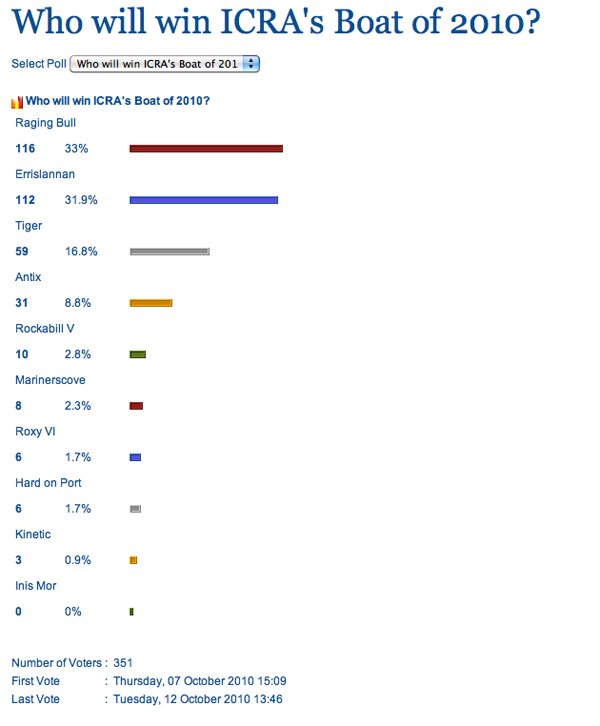
Indian Summer Forecast-Don't Put That Boat Away Just Yet!
Although we've been writing about how to look after your boat this winter in Afloat's latest issue don't hang up the lifejackets just yet! A late rush of Summer is expected across the country this weekend. Unseasonable high temperatures of up to 22 degrees have been forecast. Get the boat out, it can't last long! The best of the weather can be expected in the mid west. Met Eireann say the Indian Summer could benefit Clare and Galway the best.
MET EIREANN FORECAST : Outlook is for warm dry settled weather in most places. FRIDAY NIGHT: Very mild, humid and misty on Friday night. Dry in many areas apart from some drizzle but there will be rain in parts of Kerry. SATURDAY & SUNDAY: Warm, humid conditions are expected over the weekend and dry in most places. However it looks as if southwestern counties will have a lot of cloud with rain at times on Saturday but this dying away on Sunday. For the rest of the country the weekend looks like being dry and warm with sunshine at times, probably best during Sunday and afternoon temperatures in the high teens or around 20 degrees in parts of the west, very high for early October. Feeling cooler at times near the east coast due to a brisk easterly breeze MONDAY: Dry and bright on Monday with sunshine in many areas and afternoon temperatures a little lower in the mid to high teens but winds lighter than over the weekend, just a moderate easterly breeze.


























